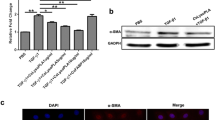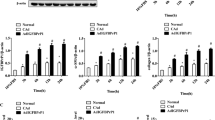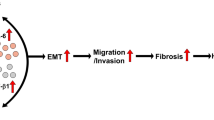Abstract
Background
Clonorchis sinensis was a food-borne zoonotic parasite in the worldwide and also an important risk factor of hepatic fibrosis. Excretory/secretion products of C. sinensis (CsESPs) are involved in parasite-host interactions and contribute to the development of hepatic damage. The aim of the present study was to investigate whether CsESPs and CsTP (adult protein) could induce autophagy of hepatic stellate cells (HSCs) and further activate HSCs so as to participate in the pathogenesis of hepatic fibrosis.
Methods and results
The human hepatic stellate cell line LX-2 was stimulated by CsESPs and CsTP. CsESPs showed the effect on cell proliferation in methyl thiazolyl tetrazolium (MTT) assay while CsTP failed. Autophagosomes and autolysosomes were observed after the transmission mRFP-EGFP-LC3 plasmid into the LX-2 cells. CsESPs had more powerful to induce the accumulation of autophagosomes and autolysosomes to enhance autophagic flux compared with CsTP. Western-blotting analysis confirmed that the ratio of LC3-II/I in LX-2 cells was up-regulated after CsESPs treatment for 6 h, which further proved that CsESPs could induce autophagy in LX-2 cells. Meanwhile, q-PCR results showed that the mRNA levels of collagen I, collagen III and α-SMA decreased in LX-2 cells after treatment with autophagy inhibitor chloroquine, whereas they increased when combination with CsESPs.
Conclusions
These results suggested that CsESPs-induced autophagy might be involved in the activation of HSCs, and consequently participate in the pathogenesis of hepatic fibrosis caused by C. sinensis infection.




Similar content being viewed by others
Data availability
The datasets used or analyzed during the current study are available from the corresponding author on reasonable request.
Code availability
Image analysis was performed using ImageJ software. Statistical analyses were performed using SPSS 22.0.
References
Zhou X (2018) Report on the national survey of important human parasitic diseases in China (2015). People’s Medical Publishing House, Beijing
Tang ZL, Huang Y, Yu XB (2016) Current status and perspectives of Clonorchis sinensis and clonorchiasis: epidemiology, pathogenesis, omics, prevention and control. Infect Dis Poverty 5(1):71. https://doi.org/10.1186/s40249-016-0166-1
Levine B, Klionsky DJ (2004) Development by self-digestion: molecular mechanisms and biological functions of autophagy. Dev Cell 6(4):463–477. https://doi.org/10.1016/s1534-5807(04)00099-1
Friedman SL (2008) Hepatic stellate cells: protean, multifunctional, and enigmatic cells of the liver. Physiol Rev 88(1):125–172. https://doi.org/10.1152/physrev.00013.2007
Hernández-Gea V, Ghiassi-Nejad Z, Rozenfeld R, Gordon R, Fiel MI, Yue Z, Czaja MJ, Friedman SL (2012) Autophagy releases lipid that promotes fibrogenesis by activated hepatic stellate cells in mice and in human tissues. Gastroenterology 142(4):938–946. https://doi.org/10.1053/j.gastro.2011.12.044
Thoen LF, Guimarães EL, Dollé L, Mannaerts I, Najimi M, Sokal E, van Grunsven LA (2011) A role for autophagy during hepatic stellate cell activation. J Hepatol 55(6):1353–1360. https://doi.org/10.1016/j.jhep.2011.07.010
Hu F, Hu X, Ma C, Xu J, Yu X (2009) Excretory/secretory antigens from Clonorchis sinensis induces hepatic fibrosis in rats. Nan Fang Yi Ke Da Xue Bao 29(3):393–396 (in Chinese)
Hu F, Hu X, Ma C, Zhao J, Xu J, Yu X (2009) Molecular characterization of a novel Clonorchis sinensis secretory phospholipase A(2) and investigation of its potential contribution to hepatic fibrosis. Mol Biochem Parasitol 167(2):127–134. https://doi.org/10.1016/j.molbiopara.2009.05.003
Wang X, Hu F, Hu X, Chen W, Huang Y, Yu X (2014) Proteomic identificationof potential Clonorchis sinensis excretory/secretory products capable of binding and activating. Parasitol Res 113(8):3063–3071. https://doi.org/10.1007/s00436-014-3972-z
Liang P, Sun J, Huang Y, Zhang F, Zhou J, Hu Y, Wang X, Liang C, Zheng M, Xu Y, Mao Q, Hu X, Li X, Xu J, Lu G, Yu X (2013) Biochemical characterization and functional analysis of fructose-1,6-bisphosphatase from Clonorchis sinensis. Mol Biol Rep 40(7):4371–4382. https://doi.org/10.1007/s11033-013-2508-4
Mao Q, Xie Z, Wang X, Chen W, Ren M, Shang M, Lei H, Tian Y, Li S, Liang P, Chen T, Liang C, Xu J, Li X, Huang Y, Yu X (2015) Clonorchis sinensis ferritin heavy chain triggers free radicals and mediates inflammation signaling in human hepatic stellate cells. Parasitol Res 114(2):659–670. https://doi.org/10.1007/s00436-014-4230-0
Zhang F, Liang P, Chen W, Wang X, Hu Y, Liang C, Sun J, Huang Y, Li R, Li X, Xu J, Yu X (2013) Stage-specific expression, immunolocalization of Clonorchis sinensis lysophospholipase and its potential role in hepatic fibrosis. Parasitol Res 112(2):737–749. https://doi.org/10.1007/s00436-012-3194-1
Yan C, Wang L, Li B, Zhang BB, Zhang B, Wang YH, Li XY, Chen JX, Tang RX, Zheng KY (2015) The expression dynamics of transforming growth factor-β/Smad signaling in the liver fibrosis experimentally caused by Clonorchis sinensis. Parasit Vectors 8:70. https://doi.org/10.1186/s13071-015-0675-y
Calès P, Chaigneau J, Hunault G, Michalak S, Cavaro-Menard C, Fasquel JB, Bertrais S, Rousselet MC (2015) Automated morphometry provides accurate and reproducible virtual staging of liver fibrosis in chronic hepatitis C. J Pathol Inform 6:20. https://doi.org/10.4103/2153-3539.157782
Kabeya Y, Mizushima N, Ueno T, Yamamoto A, Kirisako T, Noda T, Kominami E, Ohsumi Y, Yoshimori T (2000) LC3, a mammalian homologue of yeast Apg8p, is localized in autophagosome membranes after processing. EMBO J 19(21):5720–5728. https://doi.org/10.1093/emboj/19.21.5720
Klionsky DJ, Abeliovich H, Agostinis P, Agrawal DK, Aliev G, Askew DS et al (2008) Guidelines for the use and interpretation of assays for monitoring autophagy in higher eukaryotes. Autophagy 4(2):151–175. https://doi.org/10.4161/auto.5338
Chiramel AI, Best SM (2018) Role of autophagy in Zika virus infection and pathogenesis. Virus Res 254:34–40. https://doi.org/10.1016/j.virusres.2017.09.006
Jia K, Thomas C, Akbar M, Sun Q, Adams-Huet B, Gilpin C, Levine B (2009) Autophagy genes protect against Salmonella typhimurium infection and mediate insulin signaling-regulated pathogen resistance. Proc Natl Acad Sci USA 106(34):14564–14569. https://doi.org/10.1073/pnas.0813319106
Kim JK, Lee HM, Park KS, Shin DM, Kim TS, Kim YS, Suh HW, Kim SY, Kim IS, Kim JM, Son JW, Sohn KM, Jung SS, Chung C, Han SB, Yang CS, Jo EK (2017) MIR144 inhibits antimicrobial responses against Mycobacterium tuberculosis in human monocytes and macrophages by targeting the autophagy protein DRAM2. Autophagy 13(2):423–441. https://doi.org/10.1080/15548627.2016.1241922
Mattoscio D, Medda A, Chiocca S (2018) Human papilloma virus and autophagy. Int J Mol Sci 19(6):1775. https://doi.org/10.3390/ijms19061775
Choi Y, Bowman JW, Jung JU (2018) Autophagy during viral infection—a double-edged sword. Nat Rev Microbiol 16(6):341–354. https://doi.org/10.1038/s41579-018-0003-6
Huang J, Brumell JH (2014) Bacteria-autophagy interplay: a battle for survival. Nat Rev Microbiol 12(2):101–114. https://doi.org/10.1038/nrmicro3160
Losinno AD, Martínez SJ, Labriola CA, Carrillo C, Romano PS (2021) Induction of autophagy increases the proteolytic activity of reservosomes during Trypanosoma cruzi metacyclogenesis. Autophagy 17(2):439–456. https://doi.org/10.1080/15548627.2020.1720428
Li X, Zhang Y, Zhao Y, Qiao K, Feng M, Zhou H, Tachibana H, Cheng X (2020) Autophagy activated by peroxiredoxin of Entamoeba histolytica. Cells 9(11):2462. https://doi.org/10.3390/cells9112462
Thomas SA, Nandan D, Kass J, Reiner NE (2018) Countervailing, time-dependent effects on host autophagy promotes intracellular survival of Leishmania. J Biol Chem 293(7):2617–2630. https://doi.org/10.1074/jbc.M117.808675
Zhu J, Zhang W, Zhang L, Xu L, Chen X, Zhou S, Xu Z, Xiao M, Bai H, Liu F, Su C (2018) IL-7 suppresses macrophage autophagy and promotes liver pathology in Schistosoma japonicum-infected mice. J Cell Mol Med 22(7):3353–3363. https://doi.org/10.1111/jcmm.13610
Chen KY, Cheng CJ, Cheng CC, Jhan KY, Chen YJ, Wang LC (2020) The excretory/secretory products of fifth-stage larval Angiostrongylus cantonensis induces autophagy via the Sonic hedgehog pathway in mouse brain astrocytes. PLoS Negl Trop Dis 14(6):e0008290. https://doi.org/10.1371/journal.pntd.0008290
Hu X, Liu X, Bai X, Yang L, Ding J, Jin X, Li C, Zhang Y, Li Y, Yang Y, Liu M (2021) Effects of Trichinella spiralis and its excretory/secretory products on autophagy of host muscle cells in vivo and in vitro. PLoS Negl Trop Dis 15(2):e0009040. https://doi.org/10.1371/journal.pntd.0009040
Won J, Cho Y, Lee D, Jeon BY, Ju JW, Chung S, Pak JH (2019) Clonorchis sinensis excretory-secretory products increase malignant characteristics of cholangiocarcinoma cells in three-dimensional co-culture with biliary ductal plates. PLoS Pathog 15(5):e1007818. https://doi.org/10.1371/journal.ppat.1007818
Madsen JA, Farutin V, Carbeau T, Wudyka S, Yin Y, Smith S, Anderson J, Capila I (2015) Toward the complete characterization of host cell proteins in biotherapeutics via affinity depletions, LC-MS/MS, and multivariate analysis. MAbs 7(6):1128–1137. https://doi.org/10.1080/19420862.2015.1082017
Shi Y, Yu K, Liang A, Huang Y, Ou F, Wei H, Wan X, Yang Y, Zhang W, Jiang Z (2020) Identification and analysis of the tegument protein and excretory-secretory products of the carcinogenic liver fluke Clonorchis sinensis. Front Microbiol 11:555730. https://doi.org/10.3389/fmicb.2020.555730
Zhao L, Shi M, Zhou L, Sun H, Zhang X, He L, Tang Z, Wang C, Wu Y, Chen T, Shang M, Zhou X, Lin Z, Li X, Yu X, Huang Y (2018) Clonorchis sinensis adult-derived proteins elicit Th2 immune responses by regulating dendritic cells via mannose receptor. PLoS Negl Trop Dis 12(3):e0006251. https://doi.org/10.1371/journal.pntd.0006251
Zheng M, Hu K, Liu W, Li H, Chen J, Yu X (2013) Proteomic analysis of different period excretory secretory products from Clonorchis sinensis adult worms: molecular characterization, immunolocalization, and serological reactivity of two excretory secretory antigens-methionine aminopeptidase 2 and acid phosphatase. Parasitol Res 112(3):1287–1297. https://doi.org/10.1007/s00436-012-3264-4
Lotersztajn S, Julien B, Teixeira-Clerc F, Grenard P, Mallat A (2005) Hepatic fibrosis: molecular mechanisms and drug targets. Annu Rev Pharmacol Toxicol 145:605–628
Mallat A, Lotersztajn S (2013) Cellular mechanisms of tissue fibrosis. 5. Novel insights into liver fibrosis. Am J Physiol Cell Physiol 305(8):C789–C799. https://doi.org/10.1152/ajpcell.00230.2013
Acknowledgements
This research was funded by the Natural Science Foundation of Guangxi (No. 2020GXNSFAA159068 and 2019GXNSFAA245069), Guangxi First-class Discipline Project for Basic Medicine (No. GXFCDP-BM-2018), Guangdong Province University Student Innovation and Entrepreneurship Training Programs (No. S201910570080), Guangzhou Medical University Student Science and Technology Innovation Programs (No. 2018A094) China
Funding
This research was funded by the Natural Science Foundation of Guangxi (No. 2020GXNSFAA159068 and 2019GXNSFAA245069), Guangxi First-class Discipline Project for Basic Medicine (No. GXFCDP-BM-2018), Guangdong Province University Student Innovation and Entrepreneurship Training Programs (No. S201910570080), Guangzhou Medical University Student Science and Technology Innovation Programs (No. 2018A094).
Author information
Authors and Affiliations
Contributions
All authors contributed to the study. Conception, design, manuscript modification, and team coordination, etc. (CM and YL), Methodology (BZ, ZG, LL, YL, YK, and WC); Material preparation, data collection and analysis (KL, WC, JM); The first draft of the manuscript (BZ and ZG). All authors commented on previous versions of the manuscript. All authors read and approved the final manuscript.
Corresponding authors
Ethics declarations
Conflict of interest
The authors have declared that no conflicts of interest exist.
Ethical approval
All animal procedures in this study were approved by the Animal Care & Welfare Committee of Guangxi Medical University.
Consent to participate
All authors participated in the informed consent.
Consent for publication
All authors approved publication.
Additional information
Publisher's Note
Springer Nature remains neutral with regard to jurisdictional claims in published maps and institutional affiliations.
Rights and permissions
About this article
Cite this article
Zheng, B., Gao, Z., Liang, L. et al. Autophagy of hepatic stellate cell induced by Clonorchis sinensis. Mol Biol Rep 49, 1895–1902 (2022). https://doi.org/10.1007/s11033-021-07001-9
Received:
Accepted:
Published:
Issue Date:
DOI: https://doi.org/10.1007/s11033-021-07001-9




